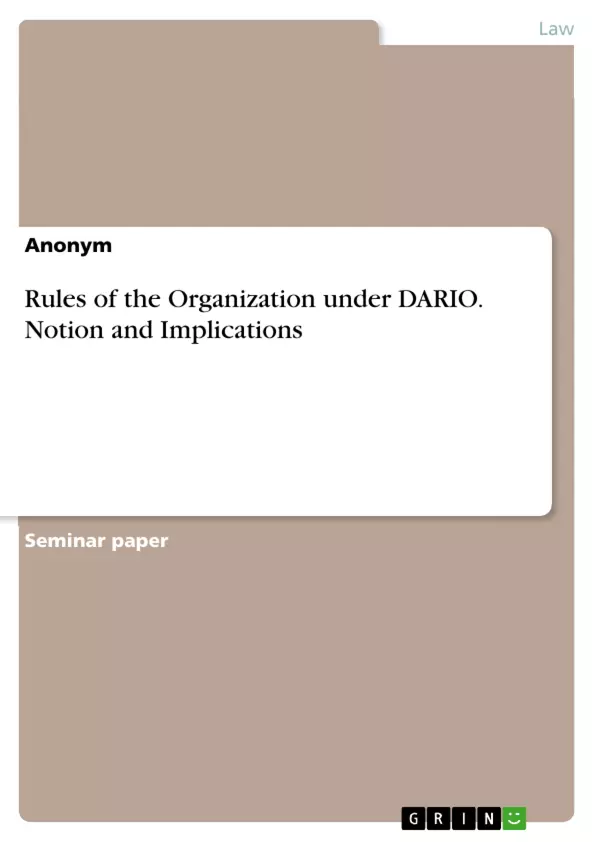International organizations are created by a treaty between at least two subjects of international law, mostly States. These confer rights and obligations to international organizations, which they have to fulfil them with their own organs. Two decisive elements materialize during the founding process of an international organization. The first one is of international nature, namely the treaty between the founding States, because they agree on the international plain. Treaties between States are always of international nature, Art. 2 I lit. a VCLT. The second one may be of internal or international nature, or both, namely the constitution instruments of an international organization. Which alternative is the right one remains unclear and thus is the subject of this paper. The latter derives from the former, whereby they both form the constituent instruments of international organizations.
Since the International Law Commission (ILC) published the Draft Articles on the responsibility of international organizations (DARIO), containing rules when an international organization is responsible for a committed international wrongful act by them, the constituent instruments of international organizations are also referred to as the “rules of the organization”. DARIO is the daughter of Responsibility of States for Internationally Wrongful Acts (ARSIWA), with the same abandonment, namely to make international organizations responsible for international wrongful acts committed by international organizations, given that ARSIWA only addresses States.
This paper will be divided into three parts. While the first and third parts are auxiliary sections to introduce the topic and present the results of this paper, the second part is the main one. Accordingly, it is divided into two subparts, namely the notion and implications. In the first subpart, the problem of the term “rules of the organization” will be discussed, while the second subpart will highlight what could happen if the constituent instruments, another expression for the term “rules of the organization”, of international organizations are qualified as natural rules, international rules or rules that are of both natures.
Inhaltsverzeichnis (Table of Contents)
- List of Abbreviations
- Bibliography
- Books
- Internet documents
Zielsetzung und Themenschwerpunkte (Objectives and Key Themes)
This work examines the law of international organizations, specifically focusing on the responsibility of these organizations and their member states. The author analyzes the legal framework governing the obligations of international organizations and explores the consequences of their non-fulfillment. Additionally, the work delves into the responsibility of member states for the acts of international organizations.
- The legal framework governing the responsibility of international organizations.
- The consequences of non-fulfillment of obligations by international organizations.
- The responsibility of member states for the acts of international organizations.
- The interplay between general international law and the internal rules of international organizations.
- The evolving nature of international law in the context of international organizations.
Zusammenfassung der Kapitel (Chapter Summaries)
This section provides a summary of the key chapters of the text.
- Chapter 1: This chapter introduces the concept of international organizations and their role in the international legal system. It discusses the different types of international organizations and their legal structures, outlining the complexities of their relationships with member states.
- Chapter 2: This chapter delves into the legal framework governing the responsibility of international organizations, focusing on the Draft Articles on the Responsibility of International Organizations (DARIO). It explores the principles of state responsibility and how they apply to international organizations.
- Chapter 3: This chapter examines the consequences of international organizations failing to fulfill their obligations, including the potential for legal action and the role of member states in addressing these failures.
- Chapter 4: This chapter focuses on the responsibility of member states for the acts of international organizations. It explores the different legal theories underpinning this responsibility and the implications for international law and international relations.
Schlüsselwörter (Keywords)
This text focuses on the legal framework surrounding the responsibility of international organizations, exploring their obligations and the consequences of non-fulfillment. Key areas of focus include the Draft Articles on the Responsibility of International Organizations (DARIO), state responsibility, and the relationship between international organizations and their member states. The work also delves into the legal theories governing the responsibility of member states for the acts of international organizations, emphasizing the evolving nature of international law in this context.
- Quote paper
- Anonym (Author), 2014, Rules of the Organization under DARIO. Notion and Implications, Munich, GRIN Verlag, https://www.grin.com/document/311488



